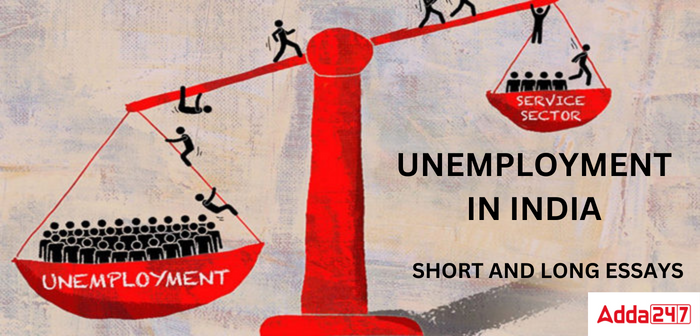The issue of unemployment has taken a disastrous form in India. In India, unemployment is still a serious and complicated problem that presents enormous obstacles for people as well as the country’s economy. India’s difficulty creating jobs and providing work opportunities has wide-ranging effects due to its large and diversified population. Students are asked to write on the topic of unemployment in India so that they can be made aware of the alarming situation. The Unemployment in India essay helps students to understand the basic causes and remedies of the unemployment issue. In this article, we will provide you with sample essays on this topic along with essays in different words and formats.
Unemployment in India
Unemployment in India: Unemployment in India is a significant barrier to growth. Some of the causes of unemployment in India include a lack of education, a lack of employment prospects, and performance problems. To solve this issue, the Indian government must act decisively. The unemployment in India rate is one of the key issues that emerging nations deal with. It has a number of other detrimental effects on both the person and society at large, making it one of the main barriers to the nation’s economic growth. India’s unemployment problem is complex and calls for a sophisticated understanding. India’s unemployment problem is complex, requiring the government, business community, and civil society to work together in a coordinated manner. The issue is complicated, but it is not unsolvable.
Unemployment in India Essay
Short and long English essays on unemployment are provided below for your understanding and enlightenment. These writings were written in clear, and simple language for students and small kids.
Essay on Unemployment in India (100- 200 words)
Unemployed people are those who are willing to work and are actively seeking employment but are unable to do so. People who choose not to work or who are unable to look for work due to a medical or mental health issue are not included.
The issue of unemployment in the nation is a result of numerous reasons. These consist of:
- Slow Industrial Development
- Rapid Population Growth
- Education with a theoretical emphasis
- Cottage industries in the fall
- lack of alternatives for farm labourers to find employment
- Technological Progress
Not only does unemployment affect people, but it also hinders national development. It has a detrimental effect on the nation’s social and economic development. Here are a few negative effects of unemployment:
- An increase in crime
- low level of living
- loss of expertise
- Political turbulence
- difficulties with mental health
- slow economic expansion
Unsurprisingly, unemployment is one of the most disregarded problems in India, despite the detrimental effects it has on society. Although the government has attempted to control the issue, its efforts have not been sufficiently successful. The government should not only start programmes to deal with this issue, but also monitor their success and make necessary revisions.
Unemployment Essay in English
Introduction
For society, unemployment is a big issue. It affects society as a whole in addition to the individuals. Unemployment is caused by a variety of circumstances. Here is a closer look at these contributing aspects as well as some potential remedies for this issue.
Factors leading to unemployment in India
- Increasing Population
The rapid increase in the population of the country is one of the leading causes of unemployment.
- Slow Economic Growth
Slow economic growth of the country results in lesser employment opportunities for people, thereby leading to unemployment.
- Seasonal Occupation
Large part of the country’s population is engaged in the agricultural sector. With this being a seasonal occupation, it provides work opportunity only for a certain part of the year.
- Slow Growth of the Industrial Sector
The growth of the industrial sector in the country is slow. Thus, the employment opportunities in this sector are limited.
- Fall in Cottage Industry
The production in the cottage industry has fallen drastically and this has left several artisans unemployed.
Possible Solutions to prevent Unemployment
- Population Control
It is high time the government of India should take stern steps to control the population of the country.
- Education System
The education system in India focuses majorly on the theoretical aspects rather than skill development. The system must be improved to generate skilled manpower.
- Industrialization
The government must take steps to boost the industrial sector to create greater opportunities for people.
- Overseas Companies
The government must encourage foreign companies to open their units in the country to generate more employment opportunities.
- Employment Opportunities
Employment opportunities must be created in rural areas for seasonally unemployed people.
Conclusion
India has long struggled with unemployment. Although the government has started a number of programmes to create jobs, the desired progress has not been made. More jobs should be created, and residents and policymakers should work together to develop employable skills and more jobs.
Unemployment in India Essay in 500 words
What is unemployment?
Unemployment is when someone is actively looking for work and is considered to be employable, they are said to be unemployed. People in the workforce who are employed but do not have suitable jobs are included in this group. Unemployment is one of the key indicators of a nation’s economic health and is typically expressed as the unemployment rate, which is calculated by dividing the number of jobless persons by the number of people in the labour force.
Types of Unemployment
Now that we are aware of what unemployment is, we can see that it encompasses more than just a lack of employment. People who work in fields outside of their competence are also included in the unemployment rate.
Included among the numerous forms of unemployment are structural unemployment, open unemployment, technological unemployment, and disguised unemployment. In addition, there are several different types of unemployment, including cyclical unemployment, educated unemployment, underemployment, frictional unemployment, chronic unemployment, and casual unemployment.
The most prevalent types of unemployment in India include underemployment, disguised unemployment, and seasonal unemployment.
Reasons of Unemployment
There are many reasons why a sizable portion of the population is unemployed in a nation like India. Among these are reasons like population growth, sluggish economic expansion, seasonal employment, sluggish economic sector growth, and a decline in cottage industries.
These are also the main causes of unemployment in India. Additionally, the situation has gotten so bad that even highly educated people are willing to work as sweepers. In addition, the government is not seriously performing his duties.
In addition to all of these, a significant majority of the population works in the agricultural sector, which only offers jobs during the harvest or plantation seasons.
India’s huge population, which needs a lot of work every year but which the government and authorities are unable to supply, is another major factor in the country’s high unemployment rate.
Consequences of Unemployment
If things continue as they are, unemployment will become a serious problem. Aside from this, an economy also results in an increase in poverty, a rise in crime, labour exploitation, political instability, mental health issues, and skill erosion. All of this will ultimately end in the collapse of the country.
Reasons of Unemployment in India
Unemployment in India is influenced by a variety of factors, both structural and cyclical. Here are some key reasons:
Population Growth: India has a large and rapidly growing population. The number of people entering the labor market each year often outpaces the number of available jobs, leading to unemployment.
Economic Slowdown: Periods of economic downturn reduce industrial and service sector growth, leading to fewer job opportunities. This has been particularly evident during global economic crises and the COVID-19 pandemic.
Skill Mismatch: There is often a gap between the skills possessed by job seekers and the skills required by employers. The education system in India sometimes fails to equip students with the practical skills needed in the job market, leading to underemployment or unemployment.
Agricultural Dependency: A large proportion of India’s workforce is still dependent on agriculture, which is often seasonal and offers low wages. Many people in rural areas remain unemployed or underemployed during off-seasons.
Technological Advancements: Automation and the adoption of new technologies in industries can reduce the need for human labor, especially in sectors like manufacturing. This can lead to job losses, particularly for those with lower skill levels.
Education System: The Indian education system focuses more on theoretical knowledge rather than practical skills. Many graduates are not job-ready, which leads to graduate unemployment.
Inadequate Infrastructure: Poor infrastructure, especially in rural areas, hampers industrial growth and the establishment of new enterprises that could create jobs.
Labor Market Regulations: Stringent labor laws and regulations can sometimes discourage companies from hiring, leading to a preference for informal or contract labor, which is often unstable.
Underemployment: Many people are employed in jobs that do not match their skill levels or education, leading to underemployment. This is common in sectors where jobs are available but do not pay well or provide job security.
Social Factors: Gender discrimination and social norms often limit employment opportunities for women and marginalized communities, contributing to higher unemployment rates in these groups.
Addressing these issues requires a multi-faceted approach, including reforming education, improving infrastructure, encouraging entrepreneurship, and creating policies that promote job creation and economic growth.
Government Initiative to Control Unemployment in 1000 words Essay
The administration has launched a number of programmes to address the unemployment issue facing the economy. The following are the policies to lower unemployment:
- TRYSEM, the government’s initiative to train rural youth for self-employment, was established in 1979. This program’s goal was to assist rural youngsters who were unemployed and between the ages of 18 and 35 in developing the skills necessary for self-employment. The SC/ST category’s women and youth were given preference under this programme.
- In order to provide chances for full employment in rural areas, the government established the Integrated Rural Development Programme (IRDP) in 1980.
- In 1982, Sri Dharmasthala Manjunatheshwara Educational Trust, Canara Bank, and Syndicate Bank jointly tried out a novel programme called RSETI/RUDSETI. RUDSETI, which stands for Rural Development and Self Employment Training Institute, was founded with the intention of addressing the youth unemployment issue. RSETIs (Rural Self Employment Training Institutes) are currently run by banks with the state and federal governments’ active participation.
- The National Rural Employment Program (NREP) and the Rural Landless Employment Guarantee Program (RLEGP) were combined into the Jawahar Rozgar Yojana (JRY) in April 1989 on the basis of an 80:20 cost-sharing arrangement between the state and the federal government.
- The Mahatma Gandhi National Rural Employment Guarantee Act, introduced in 2005, gives people the freedom to labour. A MNREGA employment programme sought to provide social security by ensuring a minimum of 100 days of paid employment annually to all families with adult members who choose unskilled labour-intensive work. Check out the provided link for more information on MNREGA.
- Pradhan Mantri Kaushal Vikas Yojana, or PMKVY, was introduced in 2015. The goal of PMKVY was to make it possible for the nation’s youth to enrol in industry-relevant skill training in order to secure a better standard of living. Visit the provided website for further information about the Pradhan Mantri Kushal Vikas Yojana.
- In 2016, the government introduced the Start-Up India Scheme. The purpose of the Startup India initiatives was to create an environment that supports and encourages entrepreneurship throughout the country. Visit the above website for further information on the Startup India Scheme.
- The Stand Up India Scheme, which was also introduced in 2016, aims to make bank loans between Rs. 10 lakh and Rs. 1 crore available to women and SC/ST borrowers for starting new businesses. On the linked page, Stand-Up India details are provided.
- The National Skill Development Mission was established in November 2014 to lead the “Skill India” agenda in “Mission Mode” and to combine speed and scale with quality and quantity of skilling activities. Take a close look at the National Skill Development Mission.
बेरोजगारी पर निबंध 300 शब्दों में
बेरोजगारी क्या है?- बेरोजगारी तब होती है जब कोई सक्रिय रूप से काम की तलाश में होता है और उसे रोजगार योग्य माना जाता है, उसे बेरोजगार कहा जाता है। कार्यबल में वे लोग जो कार्यरत हैं लेकिन उनके पास उपयुक्त नौकरी नहीं है, इस समूह में शामिल हैं। बेरोजगारी एक देश के आर्थिक स्वास्थ्य के प्रमुख संकेतकों में से एक है और इसे आमतौर पर बेरोजगारी दर के रूप में व्यक्त किया जाता है, जिसकी गणना बेरोजगार व्यक्तियों की संख्या को श्रम बल में लोगों की संख्या से विभाजित करके की जाती है।
बेरोजगारी के प्रकार- अब जब हम जानते हैं कि बेरोजगारी क्या है, तो हम देख सकते हैं कि इसमें रोजगार की कमी के अलावा और भी बहुत कुछ शामिल है। जो लोग अपनी क्षमता से बाहर के क्षेत्रों में काम करते हैं वे भी बेरोजगारी दर में शामिल हैं।
बेरोजगारी के कई रूपों में संरचनात्मक बेरोजगारी, खुली बेरोजगारी, तकनीकी बेरोजगारी और प्रच्छन्न बेरोजगारी शामिल हैं। इसके अलावा, कई अलग-अलग प्रकार की बेरोजगारी हैं, जिनमें चक्रीय बेरोजगारी, शिक्षित बेरोजगारी, अल्परोजगार, घर्षण बेरोजगारी, पुरानी बेरोजगारी और आकस्मिक बेरोजगारी शामिल हैं।
भारत में सबसे प्रचलित प्रकार की बेरोजगारी में अल्प-रोजगार, प्रच्छन्न बेरोजगारी और मौसमी बेरोजगारी शामिल हैं।
बेरोजगारी के कारण- भारत जैसे देश में आबादी का एक बड़ा हिस्सा बेरोजगार होने के कई कारण हैं। इनमें जनसंख्या वृद्धि, सुस्त आर्थिक विस्तार, मौसमी रोजगार, सुस्त आर्थिक क्षेत्र की वृद्धि और कुटीर उद्योगों में गिरावट जैसे कारण हैं।
ये भी भारत में बेरोजगारी के प्रमुख कारण हैं। इसके अतिरिक्त, स्थिति इतनी खराब हो गई है कि उच्च शिक्षित लोग भी सफाईकर्मी के रूप में काम करने को तैयार हैं। साथ ही सरकार अपने कर्तव्यों का गंभीरता से पालन नहीं कर रही है।
इन सब के अलावा, आबादी का एक महत्वपूर्ण हिस्सा कृषि क्षेत्र में काम करता है, जो केवल फसल या वृक्षारोपण के मौसम के दौरान ही रोजगार प्रदान करता है।
भारत की विशाल आबादी, जिसे हर साल बहुत अधिक काम की आवश्यकता होती है, लेकिन सरकार और अधिकारी आपूर्ति करने में असमर्थ हैं, देश की उच्च बेरोजगारी दर का एक और प्रमुख कारक है।
बेरोजगारी के परिणाम- अगर हालात ऐसे ही रहे, तो बेरोजगारी एक गंभीर समस्या बन जाएगी। इसके अलावा, एक अर्थव्यवस्था का परिणाम गरीबी में वृद्धि, अपराध में वृद्धि, श्रम शोषण, राजनीतिक अस्थिरता, मानसिक स्वास्थ्य के मुद्दों और कौशल क्षरण में भी होता है। यह सब अंततः देश के पतन में समाप्त होगा।
Related Essays Articles:
Here we are providing you with a list of some common essay topics
| Diwali Festival | Environmental Pollution |
| Mahatma Gandhi | Our country: India |
| Climate change | My aim in life |
| Morning Walk | Online Education |
| Cow essay |
![Unemployment in India Essay in 300 Words [बेरोजगारी पर निबंध]_0.1](https://www.adda247.com/jobs/wp-content/uploads/sites/2/2022/09/07185734/school.png)

![Unemployment in India Essay in 300 Words [बेरोजगारी पर निबंध]_3.1](https://www.careerpower.in/blog/wp-content/uploads/sites/2/2025/05/16181155/Neet-2026.jpeg)






 Essay on Diwali in English, Read Long an...
Essay on Diwali in English, Read Long an...
 Essay on Dussehra in English in 10 Lines...
Essay on Dussehra in English in 10 Lines...
 Navratri Essay in English- Check 10 Poin...
Navratri Essay in English- Check 10 Poin...

![Unemployment in India Essay in 300 Words [बेरोजगारी पर निबंध]_5.1](https://www.adda247.com/jobs/wp-content/uploads/sites/2/2025/09/22142718/saransh-300x300.webp)
![Unemployment in India Essay in 300 Words [बेरोजगारी पर निबंध]_6.1](https://www.adda247.com/jobs/wp-content/uploads/sites/2/2025/09/29165843/983491758610289-300x300.webp)
![Unemployment in India Essay in 300 Words [बेरोजगारी पर निबंध]_7.1](https://www.adda247.com/jobs/wp-content/uploads/sites/2/2025/10/06124635/236691756125972-300x300.webp)
![Unemployment in India Essay in 300 Words [बेरोजगारी पर निबंध]_8.1](https://www.adda247.com/jobs/wp-content/uploads/sites/2/2025/10/06125418/236361756126025-300x300.webp)
![Unemployment in India Essay in 300 Words [बेरोजगारी पर निबंध]_9.1](https://www.adda247.com/jobs/wp-content/uploads/sites/2/2025/10/06125547/236311756125830-300x300.webp)
![Unemployment in India Essay in 300 Words [बेरोजगारी पर निबंध]_10.1](https://www.adda247.com/jobs/wp-content/uploads/sites/2/2025/08/27114822/NBTS201756112382-300x300.webp)



![Unemployment in India Essay in 300 Words [बेरोजगारी पर निबंध]_14.1](https://st.adda247.com/https://storeimages.adda247.com/321761751633279.png?tr=w-undefined)
![Unemployment in India Essay in 300 Words [बेरोजगारी पर निबंध]_15.1](https://st.adda247.com/https://storeimages.adda247.com/440701751636300.png?tr=w-undefined)
